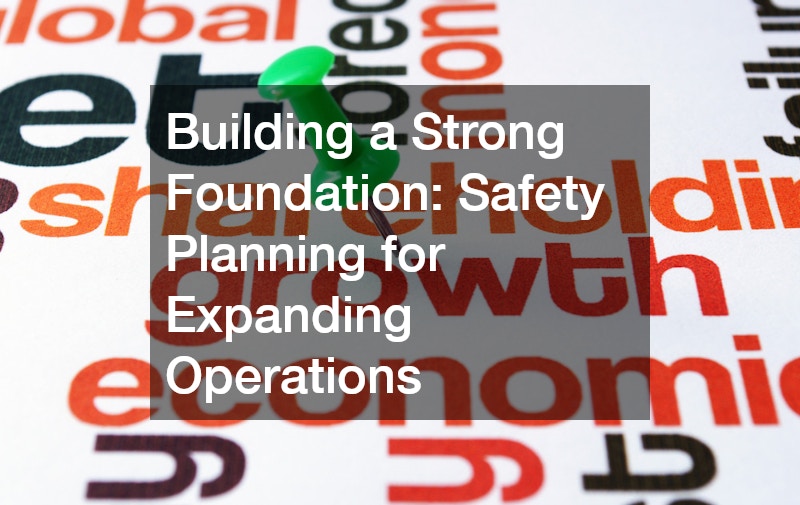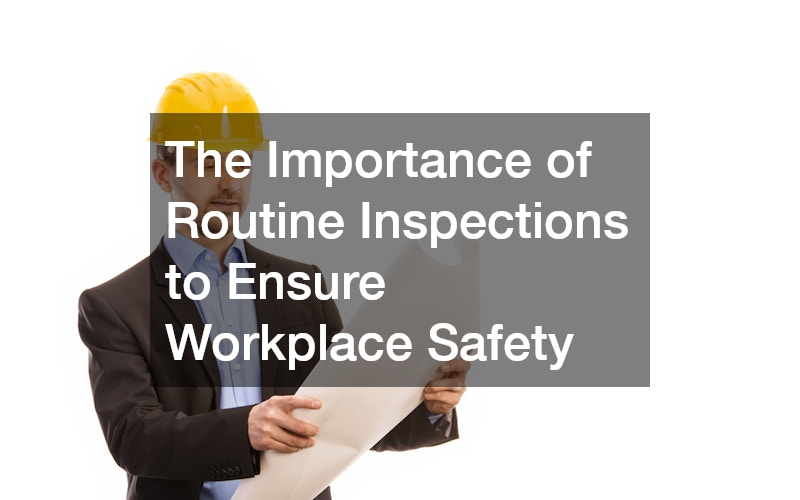In today’s fast-paced and ever-evolving business environment, maintaining high safety standards is no longer just beneficial but essential. Safety principles are the backbone of any operation, ensuring not only the well-being of employees but also the sustainability and success of the business. This article delves into the various aspects of workplace safety, focusing on proactive measures, planning, and implementation for both small and growing businesses.
As businesses expand and evolve, their operational dynamics change, leading to new safety challenges. Implementing comprehensive safety principles becomes critical in addressing these challenges, ensuring that safety protocols grow in tandem with the business. In doing so, companies can prevent accidents, reduce downtime, and maintain a healthy work environment.
The role of safety principles extends beyond accident prevention. By fostering a culture of safety, organizations can enhance productivity, boost employee morale, and improve their reputation. This not only aids in employee retention but also attracts potential clients and partners, further cementing the company’s place in the industry.
Proactive Risk Management: Preventing Accidents Before They Happen

Proactive risk management focuses on identifying potential hazards before they result in accidents. By incorporating safety principles into the daily routine, businesses can not only prevent incidents but also promote a culture of vigilance among employees. Risk assessment tools and methodologies allow organizations to preemptively address threats, emphasizing prevention over response.
Integrating safety principles with regular operational reviews can reveal hidden risks, such as the need for roof replacement or hydraulic repair service. Early detection of wear and tear enables timely intervention, avoiding costly accidents and service disruptions. Additionally, engaging skilled professionals for tasks like fence contractor work or trailer repair can mitigate risks further, as these experts bring a wealth of safety knowledge to the table.
Continual staff training is vital to successful risk management, ensuring all employees understand the latest safety principles. By encouraging an open dialogue about safety, businesses can foster an environment where safety concerns are promptly addressed. Regular workshops and safety drills help reinforce these principles, keeping the workforce prepared for any eventuality.
Building a Strong Foundation: Safety Planning for Expanding Operations

With business growth comes the need for expanded operations, necessitating robust safety planning. Safety principles play an essential role in shaping these plans, guiding businesses through the complexities of scaling. A well-integrated safety strategy ensures that new processes and facilities adhere to high safety standards, reducing the risk of accidents.
Developing a safety plan for expanding operations involves a comprehensive assessment of current practices and the identification of areas for improvement. For example, as traffic increases on-site, businesses may need to engage a tree removal service to clear driving paths and prevent visibility issues. Similarly, as equipment usage intensifies, companies must consider the implications of hydraulic repair service and regular lift station maintenance.
A proactive approach to safety planning includes collaboration with various stakeholders, from management to external contractors. Engaging a rigging service for equipment installation can enhance safety, ensuring that set-ups comply with rigorous standards. Furthermore, periodic local fire alarm inspections guarantee functionality and immediate response, safeguarding the business as it evolves.
The Importance of Routine Inspections to Ensure Workplace Safety

Regular inspections are a cornerstone of effective workplace safety management. By dedicating time and resources to inspections, businesses can detect potential safety breaches before they escalate into severe incidents. The consistent application of safety principles during inspections helps maintain a secure working environment.
Routine inspections cover a wide array of safety measures, from structural assessments like roof replacement evaluations to equipment checks such as trailer repair needs. Safety personnel also review operational aspects, ensuring compliance with protocols and identifying required improvements. With consistent monitoring, businesses can uphold safety standards, reducing the frequency and severity of workplace incidents.
Engaging third-party experts for inspections can bring an objective perspective to safety evaluations. A fence contractor, for instance, can affirm the integrity of perimeter defenses, while septic system experts ensure sanitary conditions in high-use facilities. Regular commercial office cleaning also plays a pivotal role in maintaining overall workplace hygiene and safety.
How to Protect Your Property and People with Effective Safety Protocols
Implementing effective safety protocols is crucial for protecting both people and property within any business setting. Safety principles should be at the core of these protocols, fostering an environment where accidents are minimized and safety is prioritized. From emergency procedures to daily operational guidelines, a comprehensive framework ensures a resilient approach to safety.
One key aspect is the regular review and updating of safety protocols to reflect changes in business operations and industry standards. For instance, as new facilities or equipment, such as those requiring hydraulic repair service or lift station upgrades, are introduced, existing protocols must be adapted. Collaboration with specialists, including rigging or trailer repair services, can also bolster protocol development, providing targeted safety solutions.
Employee engagement is essential in the successful implementation of safety protocols. Training sessions should emphasize adherence to safety principles, focusing on empowering employees to take an active role in safety maintenance. Regular drills and feedback mechanisms further support a culture of safety, encouraging continuous improvement and vigilance across all levels of the organization.
Creating a Safety-Focused Workplace Culture for Long-Term Success

Establishing a safety-focused workplace culture is integral to the long-term success and sustainability of any business. Safety principles should be ingrained into the company’s ethos, influencing decision-making at every level. This cultural commitment fosters an environment where employees feel valued and protected, enhancing overall morale and productivity.
Management plays a pivotal role in cultivating a safety-first mindset, embodying the values they wish to see reflected across the organization. By actively participating in safety initiatives and promoting accountability, leaders can set a positive precedent. Integrating feedback from employees and stakeholders enhances this culture, allowing for the refinement of procedures, like roof replacement planning or septic system maintenance.
Communication and transparency are foundational to a strong safety culture. Encouraging open discussions about safety principles and concerns provides valuable insights, helping to identify potential risks and solutions. Regular newsletters, safety bulletins, and recognition of safety achievements reinforce the importance of these efforts, fostering a sense of collective responsibility.
Managing Safety During Facility Upgrades and Renovations
Facility upgrades and renovations present unique safety challenges that require meticulous planning and execution. Safety principles need to be interwoven into every stage of these projects, ensuring that construction activities do not compromise the well-being of personnel or disrupt ongoing operations. This careful integration mitigates risks associated with structural modifications and the increased activity on-site.
Collaboration with experienced contractors and service providers is an effective way to manage safety during facility updates. Engaging a reputable roof replacement service, for example, can ensure that building enhancements meet established safety standards. Additionally, enlistment of professionals for tasks like fence installation or tree removals can further safeguard the property and its occupants.
Throughout the renovation process, continuous monitoring and site evaluations are critical for identifying emerging risks and adapting safety protocols accordingly. Implementing temporary measures, such as access restrictions or heightened awareness campaigns, can significantly reduce accident potential. Routine safety audits and inspections serve as checkpoints, providing assurance that safety principles are adhered to consistently.
Essential Workplace Safety Practices for Growing Businesses
As businesses expand, it becomes essential to identify and implement key safety practices that evolve alongside growth. Safety principles act as an anchor, guiding the development and enforcement of these critical practices. By tailoring safety measures to address the unique demands of a growing business, companies can ensure ongoing protection and efficiency.
Keeping employees informed and engaged is vital in maintaining a culture of safety. Regular training sessions should be organized to keep all team members up-to-date with the latest safety protocols and practices. Encouragement of proactive participation in safety discussions helps maintain a dynamic environment, with ideas and feedback contributing to the evolution of safety standards across the organization.
Adapting safety practices to accommodate new technology and layout changes is also crucial. For instance, the introduction of heavy machinery or tools requiring hydraulic repair service necessitates stringent operational guidelines and safety checks. Consistent review and adjustment of these practices ensure they remain effective, supporting a safe and productive work environment.
Mitigating Hazards in High-Traffic Areas and Workspaces
High-traffic areas and busy workplaces are susceptible to unique safety challenges requiring tailored risk mitigation strategies. Safety principles must be actively applied to manage the increased interaction and activity levels present in these dynamic environments. Implementing structured traffic flow plans and clear demarcations can help minimize collision risks and maintain order.
Regular risk assessments identify potential hazards that could affect high-use areas, such as equipment malfunction or overcrowding. For example, engaging a trailer repair service ensures all transport units operate safely, preventing breakdowns and accidents. Creating designated loading zones and installing clear signage can further enhance safety in these busy areas.
Employee training plays an essential role in hazard mitigation, equipping staff with the knowledge and skills required to identify and respond to potential threats promptly. Routine refreshers and feedback sessions reinforce the application of safety principles, empowering employees to actively contribute to a cohesive safety strategy. In doing so, businesses can maintain a secure environment, even amidst high traffic and complex operations.
The Role of Proper Equipment Maintenance in Ensuring Employee Safety
Equipment maintenance is a fundamental aspect of workplace safety, ensuring that all machinery and tools function correctly and safely. Adherence to established safety principles during maintenance supports a risk-free environment, protecting employees from avoidable accidents. Regular checks and servicing are crucial for identifying issues early and preventing equipment-related injuries.
Incorporating professional services into the maintenance schedule enhances the reliability and safety of equipment. For instance, a hydraulic repair service can address issues in complex machinery, reducing the risk of mechanical failures. Similarly, regular lift station service, performed by experts, ensures consistent operation, minimizing disruption and maintaining safe wastewater management.
Maintenance records play a critical role in sustaining equipment safety standards, offering a comprehensive overview of servicing history and pending tasks. This documentation supports efficient scheduling, prioritizing resources for areas requiring immediate attention. Routine collaborations with external contractors further enhance maintenance efforts, ensuring all equipment adheres to current safety principles and industry standards.
Streamlining Safety Protocols for Larger Teams and Expanding Operations
As businesses grow and teams expand, streamlining safety protocols becomes a priority to maintain efficiency and coherence. Safety principles act as a guide, establishing a foundation for procedure refinement and implementation. By simplifying safety protocols, businesses can ensure accessibility and understanding across diverse teams, enhancing overall compliance.
Creating a centralized repository for all safety guidelines and procedures improves accessibility and promotes consistency in their application. This approach facilitates quick reference and dissemination of safety updates, ensuring all employees are informed of any changes. Digital platforms can further streamline this process, enabling real-time access to safety resources and protocols.
Encouraging cross-departmental collaboration fosters a unified approach to safety, with employees contributing unique insights and solutions. Regular meetings and workshops provide an opportunity to address safety challenges collectively, affirming a commitment to shared safety principles. This integrated approach ensures that protocols evolve in response to the changing demands of growing teams and operations.
Ensuring Compliance with Safety Regulations as Your Business Scales
Adherence to safety regulations is essential for both legal compliance and the protection of employees and assets. As businesses scale, ensuring compliance can become increasingly complex, necessitating a comprehensive understanding of relevant local and industry-specific requirements. Safety principles form the bedrock of compliance, steering organizational practices towards regulatory alignment.
Regular audits and inspections are crucial to maintaining compliance, identifying areas where practices may fall short of legal expectations. These evaluations provide valuable insights into necessary adjustments, ensuring all safety protocols meet current standards. Engaging with experts, such as a local fire alarm inspection service or septic maintenance professionals, enhances compliance efforts, providing specialized knowledge and support.
Documentation and record-keeping are critical components of compliance management, offering a transparent overview of safety practices and regulatory actions. By meticulously documenting procedures, incidents, and corrective measures, businesses can demonstrate accountability and responsiveness to regulators. Training employees on compliance matters reinforces a shared commitment to upholding safety principles, aligning the entire workforce with regulatory standards.
The Critical Role of Fire Safety and Emergency Preparedness in Growth
Fire safety and emergency preparedness are integral components of a comprehensive safety strategy, particularly in growing businesses with expanding operations. Incorporating safety principles into emergency planning ensures rapid response and effective mitigation of potential risks. By prioritizing these elements, businesses can safeguard employees and assets, minimizing disruption during critical incidents.
Routine training sessions and drills equip employees with the skills and confidence needed to respond effectively to fire emergencies. This ongoing education ensures all team members are familiar with evacuation routes, alarm systems, and emergency measures. Collaborating with local fire alarm inspections services enhances these efforts, verifying system functionality and compliance with safety standards.
Developing robust emergency response plans involves evaluating potential risks and creating tailored strategies to address specific scenarios. These plans should incorporate roles and responsibilities, communication channels, and post-incident procedures, fostering a comprehensive and proactive approach. By integrating safety principles throughout the planning process, businesses can ensure preparedness and resilience during emergencies.
How Routine Maintenance and Safety Audits Contribute to Business Longevity
Routine maintenance and safety audits are critical to the sustained success and longevity of any business. Consistent application of safety principles during these evaluations ensures ongoing protection and operational efficiency. By actively addressing potential issues, companies can prevent costly disruptions and uphold a safe working environment.
Maintenance schedules should encompass all aspects of the business, including equipment like roof replacement and regular lift station service. Adherence to these schedules prolongs asset life, reducing unexpected failures and repair costs. Engaging responsible contractors for specialized tasks, such as hydraulic repair service or septic system maintenance, ensures high-quality service and compliance with safety standards.
Safety audits provide an independent assessment of current practices, offering valuable insights into areas requiring improvement. These evaluations facilitate the identification of emerging risks, allowing businesses to adapt their safety protocols proactively. By prioritizing routine maintenance and audits, companies can establish enduring safety principles, fostering resilience and business longevity.
Workplace safety is a dynamic, multifaceted undertaking that requires constant attention, adaptation, and commitment. By embedding safety principles into every aspect of operations, businesses can build a resilient and secure environment that protects their most valuable assets: their people and infrastructure. Proactive risk management, rigorous planning, and continuous evaluation are key to navigating the complex challenges of safety effectively.
Whether it involves managing routine inspections, coordinating facility upgrades, or preparing for emergency scenarios, adherence to safety principles ensures that businesses remain vigilant and responsive. Engaging with specialized services such as roof replacement, tree removals, or commercial office cleaning enhances these efforts, providing the expertise necessary for comprehensive safety management.
Ultimately, establishing a culture centered around safety principles not only preserves the well-being of employees but also strengthens the foundation for long-term success. By remaining committed to these principles, businesses can thrive amidst the uncertainties of growth and change, paving the way for a prosperous and sustainable future.

